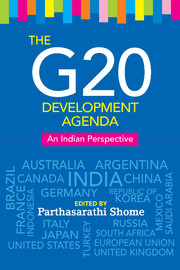Preface
Published online by Cambridge University Press: 05 May 2015
Summary
The Group of 20 nations (G20) continues to be the premier forum for global economic governance with its relative success in containing the deleterious aftermath of the global economic crisis of 2008–09. In 2010, there was an upturn experienced at a wider macro level if not at an individual economy level for which a more fundamental restructuring of the global economy would be required than was actually reached. The G20's achievement was, nevertheless, to bring together developed and emerging economies and initiate a series of macro-economic and financial sector reforms as the crisis originated from that sector, and be able to coordinate to an observable extent the policies that the members would take for cross-country stabilization.
As the global economy recovered in 2010, the G20 began expanding its brief to include a development agenda, in particular, achieving food security in an environment of commodity price volatility, recycling global savings to boost infrastructure investment, enhancing international burden sharing, and energy and environmental sustainability. Thus, the G20 embarked on a strategy to broaden its agenda that had included global macroeconomic coordination together with financial sector reforms and regulation and the reform of international financial institutions, to also include a list of development agenda pillars together with energy security and environmental sustainability. During the concerned period, India's position was that of a growing emerging economy of significant size that came off relatively unscathed by the crisis despite extensive opening up of its economy to international trade. It was well placed to influence the G20 in its functioning as a global steering entity.
A recent volume edited by Shome (2014) has examined emerging economy concerns and perspectives on reforms of the financial sector and the international monetary system, with a focus on India, set in the context of G20 reform initiatives and impasses.
- Type
- Chapter
- Information
- The G20 Development AgendaAn Indian Perspective, pp. xi - xivPublisher: Cambridge University PressPrint publication year: 2015



